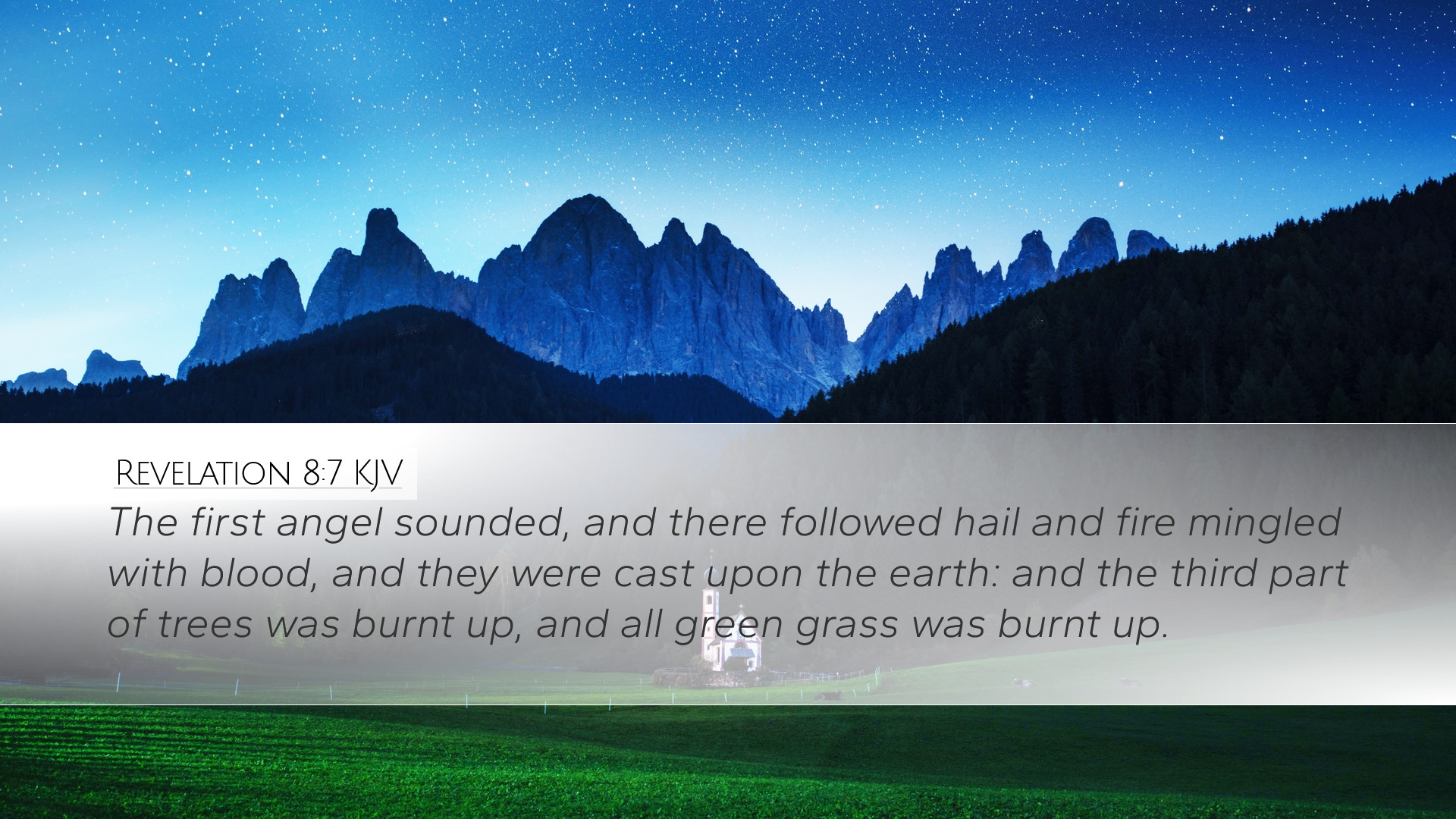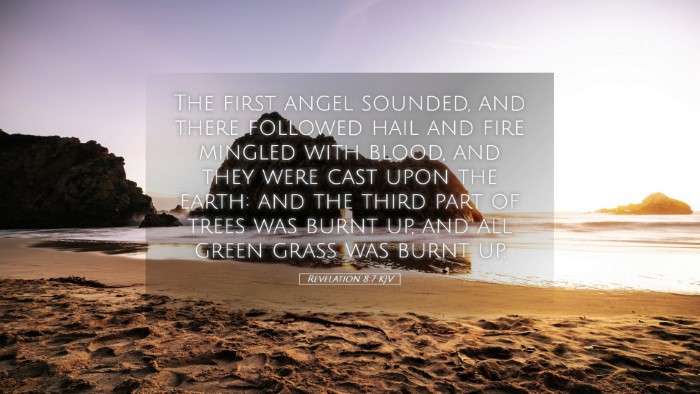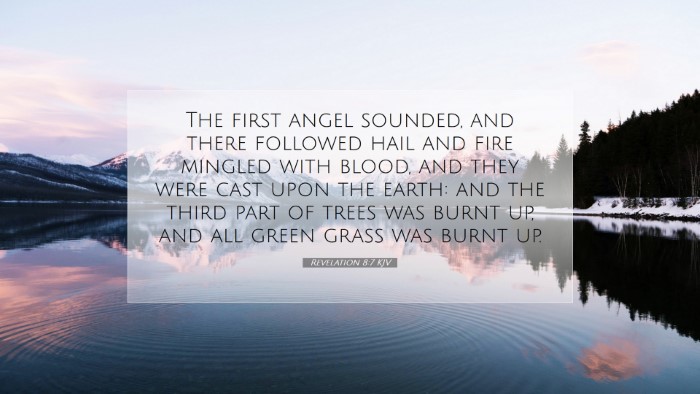Commentary on Revelation 8:7
Text of Revelation 8:7 (KJV): "The first angel sounded, and there followed hail and fire mingled with blood, and they were cast upon the earth: and the third part of trees was burnt up, and all green grass was burnt up."
Introduction
The passage found in Revelation 8:7 represents a pivotal moment in the unfolding of apocalyptic events. It sets the stage for divine judgment upon the earth, utilizing vivid imagery and symbolism that merits deep theological reflection. The commentaries from notable theologians provide insights that elucidate the meaning and implications of this verse.
Contextual Background
This verse occurs within the broader context of the seven trumpets, marking a significant judgment in the series of apocalyptic events described in John's vision. Each trumpet heralds a new phase of God's wrath upon a world that has persistently turned from Him.
Matthew Henry emphasizes that the sounding of the trumpets signifies the awakening of divine judgment, paralleling the actions of both heaven and earth as they respond to God’s commands. The first four trumpets, which include this passage, particularly call attention to ecological devastation as a form of judgment.
Albert Barnes notes that the imagery of hail and fire has deep Old Testament roots, particularly referencing God's judgment in Exodus and prophetic texts that use natural disasters to convey divine wrath. This not only serves as a warning but also as a reminder of the consequences of sin and rebellion against God.
Symbolic Interpretation
The elements of this verse—hail, fire, and blood—are rich in symbolism:
- Hail: Often symbolizes destruction and serves as a metaphor for God's severe judgment. In the ancient Near East, hail was frequently associated with divine retribution.
- Fire: Represents purity and judgment, indicating that God’s cleansing action involves severe trials. The destructive force of fire also highlights the finality of judgment.
- Blood: Suggests the cost of sin and the seriousness of divine justice. It invokes imagery of sacrifice and atonement while also serving as a stark reminder of the loss resulting from judgment.
Adam Clarke elaborates that the mingling of these elements points towards a catastrophic event, hinting at the intertwining of natural disasters with the moral decay present on earth. The blood mingled with fire and hail further illustrates the devastating outcomes of judgment upon human sin.
Judgment on Creation
The specific mention of the "third part of trees" and "all green grass" being burnt underscores the environmental implications of divine judgment. This destruction is not just a supernatural event but a direct blow to creation, signaling God's discontent with the state of the world.
Henry observes that this judgment reflects a proportional response to humanity's wickedness. The burning of a third of the earth's greenery symbolizes a significant yet restrained action from God, emphasizing mercy even in judgment. It suggests that while God’s judgment is severe, it is also purposefully measured.
Barnes reflects on how this highlights the interconnectedness of creation, revealing that human actions have destructive consequences not just on people but also on the environment. This serves as a potent reminder to believers about the stewardship of God's creation.
Theological Implications
The themes present in Revelation 8:7 raise essential theological questions for pastors and scholars alike:
- Justice and Mercy: How do we reconcile God’s judgment with His love? The balance of judgment and mercy is a recurring theme in Scripture, and this passage encapsulates the tension between divine justice and grace.
- The Nature of Sin: This judgment serves as a stark reminder of the consequences of sin. The burning of creation indicates that moral decay leads to physical consequences, prompting reflection on our relationship with God and each other.
- Eschatological Perspectives: The imagery points towards eschatological fulfillment. Believers are called to interpret these signs in light of God’s ultimate plan for restoration and redemption beyond judgment.
Clarke suggests that such passages require the church to remain vigilant and conscious of prophetic warnings, urging believers to live in a manner that reflects God’s holiness in anticipation of His return.
Practical Applications
The teachings derived from Revelation 8:7 offer profound applications for contemporary believers:
- Awareness of God’s Sovereignty: In a world filled with chaos, acknowledging God’s control over the natural world reassures believers of His ultimate authority.
- Call to Repentance: This passage serves as an invitation for self-examination and repentance, urging believers to realign their lives with God’s will and truth.
- Environmental Responsibility: Considering the ecological implications of sin as highlighted in this passage, Christians are called to be stewards of creation, actively caring for the environment as a manifestation of their faith.
Henry concludes that the urgency embedded in these prophetic warnings should mobilize believers towards evangelism and discipleship, emphasizing the importance of sharing the gospel in light of impending judgment.
Conclusion
Revelation 8:7 stands as a testament to the seriousness of God's judgment and the consequential devastation in creation due to human sin. The insights from public domain commentaries provide valuable perspectives that encourage a holistic understanding of this complex passage. For pastors, students, theologians, and Bible scholars, this verse serves not only as a warning but also as a clarion call to deeper engagement with Scripture, prompting reflection and action in the face of divine reality.


